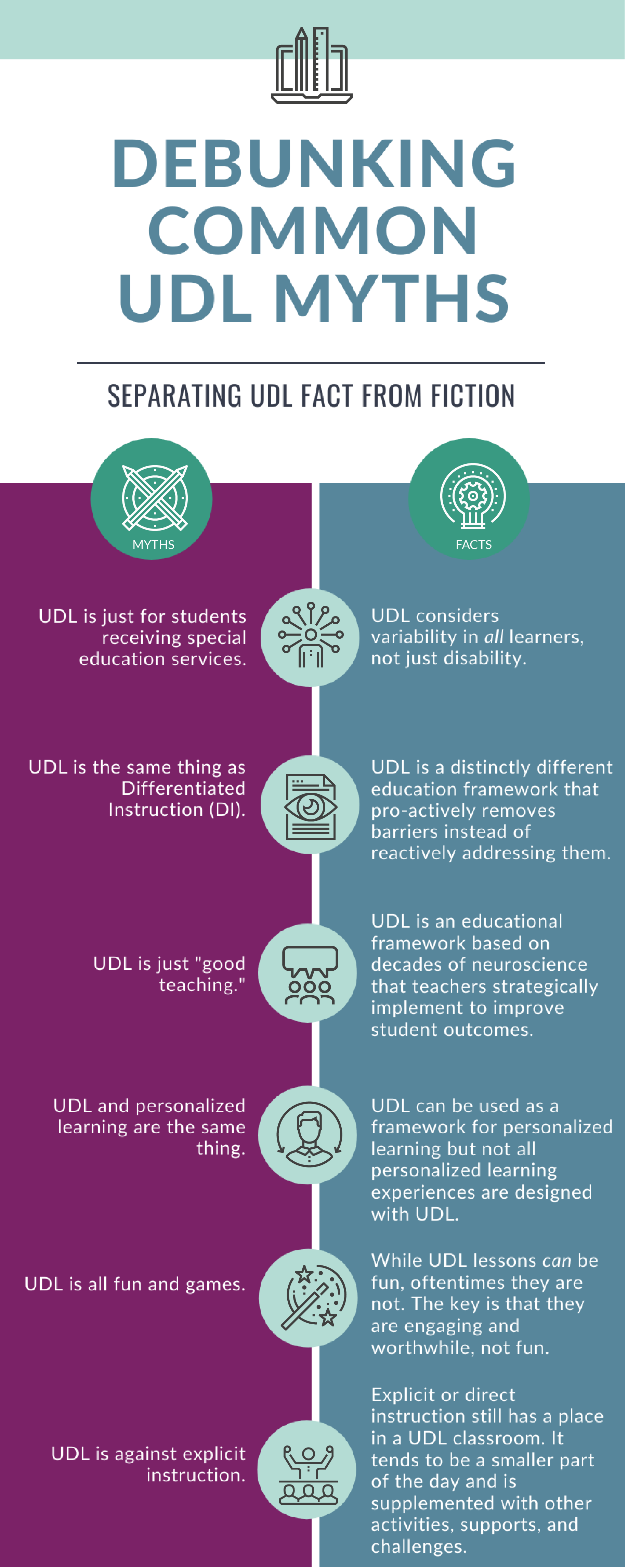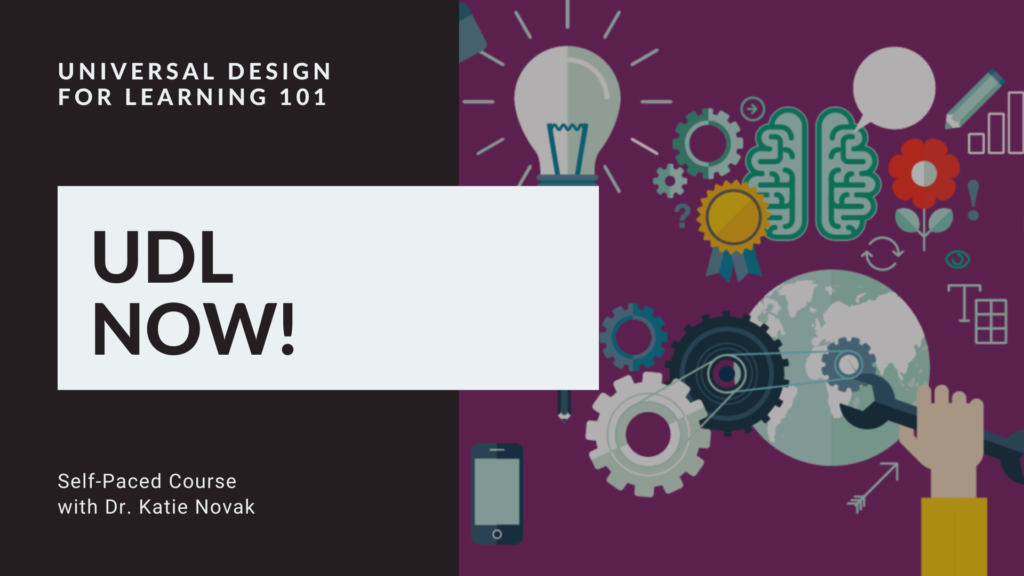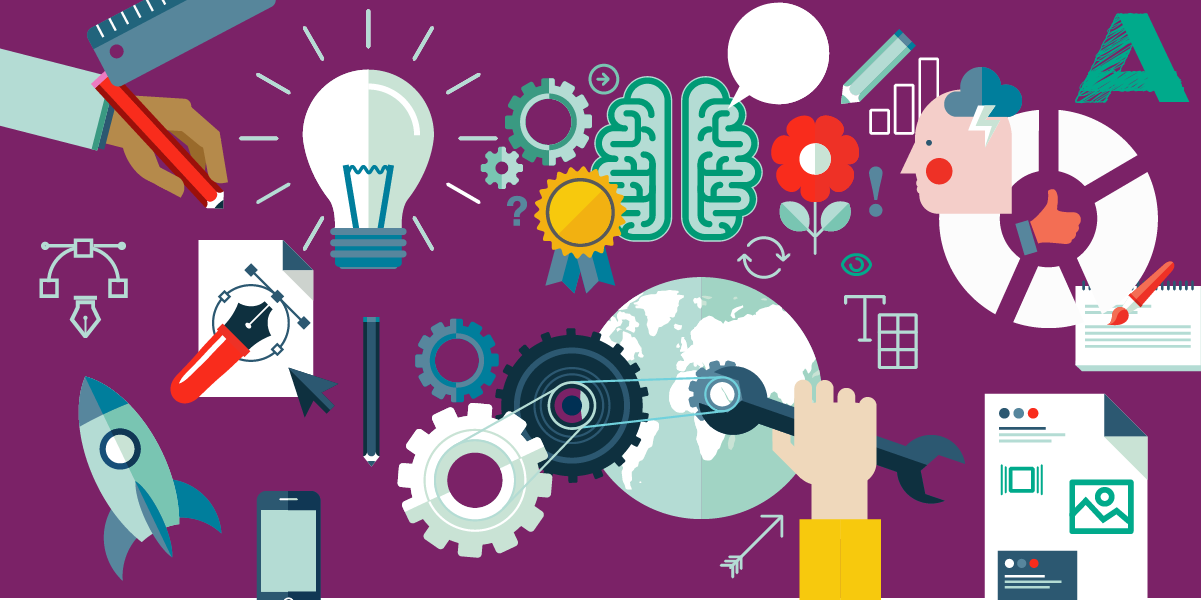You may know of UDL as a framework to improve and optimize teaching and learning for all people based on scientific insights into how humans learn. But one thing I have experienced time and time again from my experience presenting on the topic is that there are several myths and misconceptions about UDL that are common among educators. Addressing these myths may be helpful in implementing the framework in your school or district.
Myth #1: UDL is for Special Education Students
Every student regardless of variability deserves the best opportunity to develop their skills and knowledge, especially those students who have been historically marginalized. It is true that UDL grew out of efforts to help students with disabilities. The innovation came in realizing that lowering barriers for students with disabilities also lowered previously unseen barriers for other learners. This, in turn, led to a recognition that universally designed education would encompass all learners because human variability is not this/that, either/or but rather a continuum of differences that change according to context and opportunity.
All students, in a classroom that includes students with disabilities, are given options and choices so they can be equally challenged and supported. Even students who are identified as gifted and talented benefit from inclusion when three key components are met: flexibility, acceleration, and variety (Delisle, 1999). Essentially, the flexibility provides all students with options and choices for the methods they use to learn, the materials, and the assessments. Acceleration allows students to move at a quicker pace if they show competency of the material, and lastly, variety allows students to personalize their learning and create meaning for themselves as they work toward standards. All three of these conditions are required in the UDL framework.
Myth #2: UDL is Differentiated Instruction (DI)
UDL and DI are built on fundamentally different values of who is in charge of a student’s learning. The primary goal of UDL is to create expert learners. UDL honors student variability and removes barriers to student learning by embracing differences.
When teachers differentiate instruction, they cater to individual student needs (Tomlinson, 2000). For example, you may take one group of students aside and ask them to read an extra piece of literature because you have evidence that they are more advanced than their peers. You ask another student to draw pictures instead of writing an essay since you know writing is challenging for him.
On the contrary, UDL proactively designs flexibility in goals, methods, materials and assessments by embracing variability and predicting barriers, and then eliminating those barriers through design. These frameworks complement each other in a multi-tiered system. When predicting variability, educators can design robust opportunities for all learners to access grade-level rigor in Tier 1 with UDL. When evidence suggests that students need additional support, intervention, or enrichment, teachers can differentiate instruction to supplement, not supplant, universally designed learning experiences.
Myth #3: UDL is just “Good teaching”
There is no variable more critical for student success than the quality of teachers (Hall & Simeral, 2017). Without a doubt, the best investment a school can make is in its human resources. Teaching is the foundation of learning, and so when we have so many students who are not successful in school, and who haven’t learned standards, we have to re-evaluate what good teaching is.
UDL is an educational framework based on decades of research in learning and the brain. It takes years to master and teachers use it to strategically remove barriers in lesson design by focusing on providing multiple means of engagement, representation, and action & expression. Teachers aim to create instructional experiences that allow students to become purposeful and motivated, resourceful and knowledgeable, and strategic and goal directed, also known as “expert learners.” In a nutshell, while following UDL best practices is good teaching, good teaching isn’t always universally designed instruction.

When UDL is successful, learners truly have ownership in their learning, as opposed to permission to make choices. One great resource to exemplify this is the UDL Progression Rubric (Novak & Rodriguez, 2018). What you will notice is that some “good teaching” strategies, where teachers offer options and choices to students, are only identified in the “emerging” UDL category. That is because UDL is all about learning, and UDL implementation is only approaching an expert level when all students, regardless of variability, are learners who understand the importance of setting goals, and creating pathways to meet those goals.
Myth #4: UDL is the Same as Personalized Learning
Many people will also say that UDL simply allows each student to go their own way and demonstrate what they know and that it results in personalized learning. Although there are some similarities, the two terms are not synonymous.
Personalized learning (PL) is when educators cater to the strengths, interests, and needs of students through instructional strategies, personalized goals, and mastery-based assessments in flexible learning environments (Bingham & Dimandja, 2017). As outlined in a research paper that reported on the results of a multiyear, multimethod study of nearly forty (40) schools implementing PL, “Personalized learning is not a codified program or set of practices that schools can readily adopt.” Elizabeth Steiner of the RAND Corporation explained that her recent studies of personalized learning suggest that “what’s happening in the field right now is a lot of innovation and a lot of schools building their [personalized learning] models, building their curriculum, and inventing new systems” (Herald, 2017).
Using that definition, Universal Design for Learning (UDL) is a framework that could be used to implement and optimize personalized learning, but it isn’t explicitly required as a component of the initiative. As the field of personalized learning continues to scale, we are hopeful that UDL will emerge as the primary framework for allowing all students to thrive.
Myth #5: UDL is all about Fun!
Learning doesn’t have to be fun to be effective. It does, however, need to be engaging, challenging, and worthwhile. Take a favorite hobby, for example, and consider if it’s “fun” all the time. It’s not. Sometimes it sucks. The Spartan Beast is a half-marathon up a mountain with 30 obstacles including delights such as getting scratched by barbed wire and lugging 40 pounds logs up a steep incline. It’s incredibly rewarding and requires expert learning, but at the time – not fun.
UDL is sometimes mischaracterized as a way of teaching and learning that is fun because when teachers proactively design flexible learning experiences with multiple options, learners have choices which makes them more likely to choose tasks that they find engaging.
But thinking that the intent of UDL is fun allows a scientific framework to be brushed off as a fad or lacking in rigor. I have designed very fun UDL lessons, and I have also designed lessons where learners were working extremely hard, pushing their intellectual abilities to the limit, stressed, and engaged, but not having fun.
Myth #6: UDL is Anti Explicit Instruction
All too often educators think that there is no place for direct or explicit instruction in a UDL classroom. This couldn’t be further from the truth. Direct instruction will always have a place in education, but the way direct instruction is delivered through UDL is quite different. To support the direct instruction, teachers provide students with options and choices to help support their learning and offer multiple ways to students to dive more deeply into the information covered through direct instruction, for example by choosing to read a chapter in a book, watching a video, discussing the concepts learned with a peer, or diving into an experiment. Whichever option the student chooses, there will be resources available to help them through struggles, such as scaffolds and exemplars. There will be frequent reminders about the goals of the lesson, and classroom norms to support students with finding resources when they are challenged. So, while a lesson may incorporate mini-lessons and direct instruction, UDL encourages teachers to go beyond the “sage on the stage” of the olden days and help students take charge of their own learning.
Download the Infographic: Debunking Common Myths of UDL
Ready for more? Learn about the what, the why, and the how of UDL

References:
- Bingham, Andrea & Dimandja, Oluwafolakemi. (2017). Staying on track: Examining teachers’ experiences in a personalized learning model.Journal of Ethnographic & Qualitative Research. 12.
- Delisle, J. R. (1999). For Gifted Students, Full Inclusion Is a Partial Solution. Educational Leadership, 57(3), 80.
- Hall, P., & Simeral, A. (2017). Creating a Culture of Reflective Practice: Capacity-Building for Schoolwide Success. Alexandria, VA: ASCD.
- Herald, B. (2017). 6 Key Insights: RAND Corp. Researchers Talk Personalized Learning. Retrieved from https://www.edweek.org/ew/articles/2017/11/08/6-key-insights-rand-corp-researchers-talk.html
- Novak, K. & Rodriguez, K. (2018). UDL progression rubric. Retrieved from http://castpublishing.org/wp-content/uploads/2018/02/UDL_Progression_Rubric_FINAL_Web_REV1.pdf
- Tomlinson, C. A. (2000a). The Differentiated Classroom: Responding to the Needs of all Learners. Alexandria: Association for Supervision and Curriculum Development.



